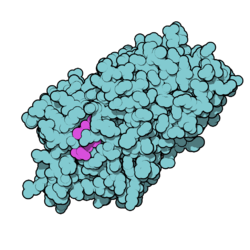Thyroxine-binding globulin
| Thyroxine-binding globulin | ||
|---|---|---|

|
||
| Calotte model of the thyroxine-binding globulin (blue) with bound thyroxine (pink) according to PDB 2CEO | ||
| Properties of human protein | ||
| Mass / length primary structure | 395 amino acids | |
| Identifier | ||
| Gene names | SERPINA7 ; TBG | |
| External IDs | ||
| Inhibitor classification | ||
| MEROPS | I04.955 | |
| Occurrence | ||
| Parent taxon | Mammals | |
Thyroxine-binding globulin ( TBG ) is a specific transport protein for the thyroid hormones L-thyroxine (T4) and triiodothyronine (T3), which occurs in mammals . Humans produce TBG in the liver , from where it is released into the blood. Mutations in SERPINA7 - gene can cause hereditary TBG deficiency.
Transport of thyroid hormones
L-thyroxine (T4) is more than 99.9% bound to transport proteins in human blood serum , only about 0.03% is free hormone (fT4). Triiodothyronine (T3) is also bound to over 99%, around 0.3% is free (fT3).
TBG is the transport protein with the highest affinity for the thyroid hormones. Other proteins that can bind T4 and T3 with a lower affinity are transthyretin (TTR, prealbumin) and, unspecifically, albumin . This makes up a smaller proportion. SHBG ( sex hormone binding globulin ) is also able to bind the thyroid hormones.
The primary structure of TBG consists of 395 amino acids. TBG has a molecular mass of about 54 kDa . It can bind one molecule of thyroid hormone per molecule. Its serum concentration in humans is about 260 n mol / l (15 µg / ml). Since protein binding prevents rapid renal elimination , the biological half-life of T4 is about 5 to 8 days, for T3 only about 19 hours, as it has a 10 to 20-fold lower affinity for TBG and does not bind to transthyretin at all . The biologically inactive rT3 has an even lower binding to the serum proteins and therefore only a serum half-life of about four hours.
The total concentration of T4 and T3 - but not the concentration of the biologically active free hormones - essentially depends on the concentration and composition of the binding proteins.
Influencing factors
The serum concentration of TBG is influenced by the following factors:
| TBG increased | TBG humbled |
|---|---|
| pregnancy | |
| Contraceptives , estrogen preparations | |
| Drugs, e.g. B. | Drugs, e.g. B. |
| Hunger | severe catabolic states |
| acute hepatitis | nephrotic syndrome |
| compensated cirrhosis of the liver | decompensated cirrhosis of the liver |
| acute intermittent porphyria | active acromegaly |
| genetically conditioned | genetically conditioned |
swell
literature
- Hotze, Lothar-Andreas; Schumm-Draeger, Petra-Maria; Thyroid Diseases: Diagnosis and Therapy; 5th edition Berlin 2003; ISBN 3-88040-002-4
See also
- Thyroglobulin , a tumor marker of the thyroid gland